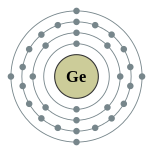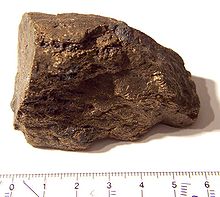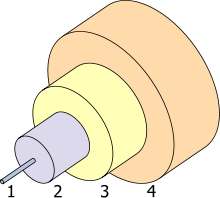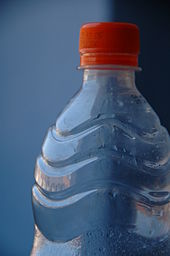
Germanium
Background Information
SOS Children volunteers helped choose articles and made other curriculum material SOS Children works in 45 African countries; can you help a child in Africa?
| Germanium | |||||||||||||||||||||||||||||||||||||||||||||||||
|---|---|---|---|---|---|---|---|---|---|---|---|---|---|---|---|---|---|---|---|---|---|---|---|---|---|---|---|---|---|---|---|---|---|---|---|---|---|---|---|---|---|---|---|---|---|---|---|---|---|
|
32Ge
|
|||||||||||||||||||||||||||||||||||||||||||||||||
|
|||||||||||||||||||||||||||||||||||||||||||||||||
| Appearance | |||||||||||||||||||||||||||||||||||||||||||||||||
grayish-white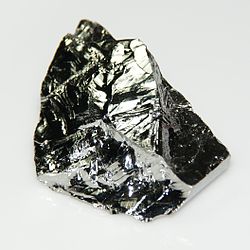 A 12 gram (2x3 cm) polycrystalline block of Ge with uneven cleaved surfaces |
|||||||||||||||||||||||||||||||||||||||||||||||||
| General properties | |||||||||||||||||||||||||||||||||||||||||||||||||
| Name, symbol, number | germanium, Ge, 32 | ||||||||||||||||||||||||||||||||||||||||||||||||
| Pronunciation | / dʒ ər ˈ m eɪ n i ə m / jər-MAY-nee-əm |
||||||||||||||||||||||||||||||||||||||||||||||||
| Element category | metalloid | ||||||||||||||||||||||||||||||||||||||||||||||||
| Group, period, block | 14, 4, p | ||||||||||||||||||||||||||||||||||||||||||||||||
| Standard atomic weight | 72.63(1) | ||||||||||||||||||||||||||||||||||||||||||||||||
| Electron configuration | [Ar] 3d10 4s2 4p2 2, 8, 18, 4 |
||||||||||||||||||||||||||||||||||||||||||||||||
| History | |||||||||||||||||||||||||||||||||||||||||||||||||
| Prediction | Dmitri Mendeleev (1871) | ||||||||||||||||||||||||||||||||||||||||||||||||
| Discovery | Clemens Winkler (1886) | ||||||||||||||||||||||||||||||||||||||||||||||||
| Physical properties | |||||||||||||||||||||||||||||||||||||||||||||||||
| Phase | solid | ||||||||||||||||||||||||||||||||||||||||||||||||
| Density (near r.t.) | 5.323 g·cm−3 | ||||||||||||||||||||||||||||||||||||||||||||||||
| Liquid density at m.p. | 5.60 g·cm−3 | ||||||||||||||||||||||||||||||||||||||||||||||||
| Melting point | 1211.40 K, 938.25 °C, 1720.85 °F | ||||||||||||||||||||||||||||||||||||||||||||||||
| Boiling point | 3106 K, 2833 °C, 5131 °F | ||||||||||||||||||||||||||||||||||||||||||||||||
| Heat of fusion | 36.94 kJ·mol−1 | ||||||||||||||||||||||||||||||||||||||||||||||||
| Heat of vaporization | 334 kJ·mol−1 | ||||||||||||||||||||||||||||||||||||||||||||||||
| Molar heat capacity | 23.222 J·mol−1·K−1 | ||||||||||||||||||||||||||||||||||||||||||||||||
| Vapor pressure | |||||||||||||||||||||||||||||||||||||||||||||||||
|
|||||||||||||||||||||||||||||||||||||||||||||||||
| Atomic properties | |||||||||||||||||||||||||||||||||||||||||||||||||
| Oxidation states | 4, 3, 2, 1, 0, -1, -2, -3, -4 ( amphoteric oxide) |
||||||||||||||||||||||||||||||||||||||||||||||||
| Electronegativity | 2.01 (Pauling scale) | ||||||||||||||||||||||||||||||||||||||||||||||||
| Ionization energies | 1st: 762 kJ·mol−1 | ||||||||||||||||||||||||||||||||||||||||||||||||
| 2nd: 1537.5 kJ·mol−1 | |||||||||||||||||||||||||||||||||||||||||||||||||
| 3rd: 3302.1 kJ·mol−1 | |||||||||||||||||||||||||||||||||||||||||||||||||
| Atomic radius | 122 pm | ||||||||||||||||||||||||||||||||||||||||||||||||
| Covalent radius | 122 pm | ||||||||||||||||||||||||||||||||||||||||||||||||
| Van der Waals radius | 211 pm | ||||||||||||||||||||||||||||||||||||||||||||||||
| Miscellanea | |||||||||||||||||||||||||||||||||||||||||||||||||
| Crystal structure | diamond cubic | ||||||||||||||||||||||||||||||||||||||||||||||||
| Magnetic ordering | Diamagnetic | ||||||||||||||||||||||||||||||||||||||||||||||||
| Electrical resistivity | (20 °C) 1 Ω·m | ||||||||||||||||||||||||||||||||||||||||||||||||
| Thermal conductivity | 60.2 W·m−1·K−1 | ||||||||||||||||||||||||||||||||||||||||||||||||
| Thermal expansion | 6.0 µm/(m·K) | ||||||||||||||||||||||||||||||||||||||||||||||||
| Speed of sound (thin rod) | (20 °C) 5400 m·s−1 | ||||||||||||||||||||||||||||||||||||||||||||||||
| Young's modulus | 103 GPa | ||||||||||||||||||||||||||||||||||||||||||||||||
| Shear modulus | 41 GPa | ||||||||||||||||||||||||||||||||||||||||||||||||
| Bulk modulus | 75 GPa | ||||||||||||||||||||||||||||||||||||||||||||||||
| Poisson ratio | 0.26 | ||||||||||||||||||||||||||||||||||||||||||||||||
| Mohs hardness | 6.0 | ||||||||||||||||||||||||||||||||||||||||||||||||
| CAS registry number | 7440-56-4 | ||||||||||||||||||||||||||||||||||||||||||||||||
| Band gap energy at 300 K | 0.67 eV | ||||||||||||||||||||||||||||||||||||||||||||||||
| Most stable isotopes | |||||||||||||||||||||||||||||||||||||||||||||||||
| Main article: Isotopes of germanium | |||||||||||||||||||||||||||||||||||||||||||||||||
|
|||||||||||||||||||||||||||||||||||||||||||||||||
Germanium is a chemical element with symbol Ge and atomic number 32. It is a lustrous, hard, grayish-white metalloid in the carbon group, chemically similar to its group neighbors tin and silicon. Purified germanium is a semiconductor, with an appearance most similar to elemental silicon. Like silicon, germanium naturally reacts and forms complexes with oxygen in nature. Unlike silicon, it is too reactive to be found naturally on Earth in the free (native) state.
Because very few minerals contain it in high concentration, germanium was discovered comparatively late in the history of chemistry. Germanium ranks near fiftieth in relative abundance of the elements in the Earth's crust. In 1869, Dmitri Mendeleev predicted its existence and some of its properties based on its position on his periodic table and called the element ekasilicon. Nearly two decades later, in 1886, Clemens Winkler found the new element along with silver and sulfur, in a rare mineral called argyrodite. Although the new element somewhat resembled arsenic and antimony in appearance, its combining ratios in the new element's compounds agreed with Mendeleev's predictions for a predicted relative of silicon. Winkler named the element after his country, Germany. Today, germanium is mined primarily from sphalerite (the primary ore of zinc), though germanium is also recovered commercially from silver, lead, and copper ores.
Germanium "metal" (isolated germanium) is used as semiconductor in transistors and various other electronic devices. Historically the first decade of semiconductor electronics were entirely based on germanium, although its production for such use today is a small fraction (2%) of that of ultra-high purity silicon, which has largely replaced it. Germanium's major end uses in the present are fibre-optic systems and infrared optics. It is used in solar cell applications. Germanium compounds are used for polymerization catalysts. Germanium is finding a new use in nanowires. Germanium forms a large number of organometallic compounds, such as tetraethylgermane, which are useful in chemistry.
Germanium is not thought to be an essential element for any living organism. Some complexed organic germanium compounds are being investigated as possible pharmaceuticals but none has had success. Similar to silicon and aluminium, natural germanium compounds, which tend to be insoluble in water, have little oral toxicity. However, synthetic soluble germanium salts are nephrotoxic, and synthetic chemically reactive germanium compounds with halogens and hydrogen are irritants and toxins.
History
In his report on The Periodic Law of the Chemical Elements, in 1869, the Russian chemist Dmitri Ivanovich Mendeleev predicted the existence of several unknown chemical elements, including one that would fill a gap in the carbon family in his Periodic Table of the Elements, located between silicon and tin. Because of its position in his Periodic Table, Mendeleev called it ekasilicon (Es), and he estimated its atomic weight as about 72.0.
In mid-1885, at a mine near Freiberg, Saxony, a new mineral was discovered and named argyrodite, because of its high silver content. The chemist Clemens Winkler analyzed this new mineral, which proved to be a combination of silver, sulfur, and a new element. Winkler was able to isolate this new element and found it somewhat similar to antimony, in 1886. Before Winkler published his results on the new element, he decided that he would name his element neptunium, since the recent discovery of planet Neptune in 1846 had been preceded by mathematical predictions of its existence. However, the name "neptunium" had already been given to another proposed chemical element (though not the element that today bears the name neptunium, which was discovered in 1940), so instead, Winkler named the new element germanium (from the Latin word, Germania, for Germany) in honour of his homeland. Argyrodite proved empirically to be Ag8GeS6.
Because this new element showed some similarities with the elements arsenic and antimony, its proper place in the periodic table was under consideration, but its similarities with Dmitri Mendeleev's predicted element "ekasilicon" confirmed that it belonged in this place on the periodic table. With further material from 500 kg of ore from the mines in Saxony, Winkler confirmed the chemical properties of the new element in 1887. He also determined an atomic weight of 72.32 by analyzing pure germanium tetrachloride (GeCl4), while Lecoq de Boisbaudran deduced 72.3 by a comparison of the lines in the spark spectrum of the element.
Winkler was able to prepare several new compounds of germanium, including its fluorides, chlorides, sulfides, germanium dioxide, and tetraethylgermane (Ge(C2H5)4), the first organogermane. The physical data from these compounds — which corresponded well with Mendeleev's predictions — made the discovery an important confirmation of Mendeleev's idea of element periodicity. Here is a comparison between the prediction and Winkler's data:
| Property | Ekasilicon | Germanium |
|---|---|---|
| atomic mass | 72.64 | 72.59 |
| density (g/cm3) | 5.5 | 5.35 |
| melting point (°C) | high | 947 |
| colour | gray | gray |
| oxide type | refractory dioxide | refractory dioxide |
| oxide density (g/cm3) | 4.7 | 4.7 |
| oxide activity | feebly basic | feebly basic |
| chloride boiling point (°C) | under 100 | 86 (GeCl4) |
| chloride density (g/cm3) | 1.9 | 1.9 |
Until the late 1930s, germanium was thought to be a poorly conducting metal. Germanium did not become economically significant until after 1945, when its properties as a semiconductor were recognized as being very useful in electronics. However, during World War II, small amounts of germanium had begun to be used in some special electronic devices, mostly diodes. Its first major use was the point-contact Schottky diodes for radar pulse detection during the War. The first silicon-germanium alloys were obtained in 1955. Before 1945, only a few hundred kilograms of germanium were produced in smelters each year, but by the end of the 1950s, the annual worldwide production had reached 40 metric tons.
The development of the germanium transistor in 1948 opened the door to countless applications of solid state electronics. From 1950 through the early 1970s, this area provided an increasing market for germanium, but then high-purity silicon began replacing germanium in transistors, diodes, and rectifiers. For example, the company that became Fairchild Semiconductor was founded in 1957 with the express purpose of producing silicon transistors. Silicon has superior electrical properties, but it requires far higher purity, and this purity could not be commercially achieved in the early years of semiconductor electronics.
Meanwhile, the demand for germanium for use in fibre optics communication networks, infrared night vision systems, and polymerization catalysts increased dramatically. These end uses represented 85% of worldwide germanium consumption in 2000. The U.S. government even designated germanium as a strategic and critical material, calling for a 146 ton (132 t) supply in the national defense stockpile in 1987.
Germanium differs from silicon in that the supply for germanium is limited by the availability of exploitable sources, while the supply of silicon is only limited by production capacity since silicon comes from ordinary sand or quartz. As a result, while silicon could be bought in 1998 for less than $10 per kg, the price of 1 kg of germanium was then almost $800.
Characteristics
Under standard conditions germanium is a brittle, silvery-white, semi-metallic element. This form constitutes an allotrope technically known as α-germanium, which has a metallic luster and a diamond cubic crystal structure, the same as diamond. At pressures above 120 kbar, a different allotrope known as β-germanium forms, which has the same structure as β-tin. Along with silicon, gallium, bismuth, antimony, and water, it is one of the few substances that expands as it solidifies (i.e. freezes) from its molten state.
Germanium is a semiconductor. Zone refining techniques have led to the production of crystalline germanium for semiconductors that has an impurity of only one part in 1010, making it one of the purest materials ever obtained. The first metallic material discovered (in 2005) to become a superconductor in the presence of an extremely strong electromagnetic field was an alloy of germanium with uranium and rhodium.
Pure germanium is known to spontaneously extrude very long screw dislocations. They are one of the primary reasons for the failure of older diodes and transistors made from germanium; depending on what they eventually touch, they may lead to an electrical short.
Chemistry
Elemental germanium oxidizes slowly to GeO2 at 250 °C. Germanium is insoluble in dilute acids and alkalis but dissolves slowly in concentrated sulfuric acid and reacts violently with molten alkalis to produce germanates ([GeO3]2−). Germanium occurs mostly in the oxidation state +4 although many compounds are known with the oxidation state of +2. Other oxidation states are rare, such as +3 found in compounds such as Ge2Cl6, and +3 and +1 observed on the surface of oxides, or negative oxidation states in germanes, such as −4 in GeH4. Germanium cluster anions ( Zintl ions) such as Ge42−, Ge94−, Ge92−, [(Ge9)2]6− have been prepared by the extraction from alloys containing alkali metals and germanium in liquid ammonia in the presence of ethylenediamine or a cryptand. The oxidation states of the element in these ions are not integers—similar to the ozonides O3−.
Two oxides of germanium are known: germanium dioxide (GeO2, germania) and germanium monoxide, (GeO). The dioxide, GeO2 can be obtained by roasting germanium disulfide (GeS2), and is a white powder that is only slightly soluble in water but reacts with alkalis to form germanates. The monoxide, germanous oxide, can be obtained by the high temperature reaction of GeO2 with Ge metal. The dioxide (and the related oxides and germanates) exhibits the unusual property of having a high refractive index for visible light, but transparency to infrared light. Bismuth germanate, Bi4Ge3O12, (BGO) is used as a scintillator.
Binary compounds with other chalcogens are also known, such as the di sulfide (GeS2), di selenide (GeSe2), and the monosulfide (GeS), selenide (GeSe), and telluride (GeTe). GeS2 forms as a white precipitate when hydrogen sulfide is passed through strongly acid solutions containing Ge(IV). The disulfide is appreciably soluble in water and in solutions of caustic alkalis or alkaline sulfides. Nevertheless, it is not soluble in acidic water, which allowed Winkler to discover the element. By heating the disulfide in a current of hydrogen, the monosulfide (GeS) is formed, which sublimes in thin plates of a dark colour and metallic luster, and is soluble in solutions of the caustic alkalis. Upon melting with alkaline carbonates and sulfur, germanium compounds form salts known as thiogermanates.
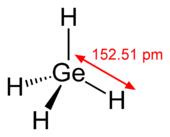
Four tetra halides are known. Under normal conditions GeI4 is a solid, GeF4 a gas and the others volatile liquids. For example, germanium tetrachloride, GeCl4, is obtained as a colorless fuming liquid boiling at 83.1 °C by heating the metal with chlorine. All the tetrahalides are readily hydrolyzed to hydrated germanium dioxide. GeCl4 is used in the production of organogermanium compounds. All four dihalides are known and in contrast to the tetrahalides are polymeric solids. Additionally Ge2Cl6 and some higher compounds of formula GenCl2n+2 are known. The unusual compound Ge6Cl16 has been prepared that contains the Ge5Cl12 unit with a neopentane structure.
Germane (GeH4) is a compound similar in structure to methane. Polygermanes—compounds that are similar to alkanes—with formula GenH2n+2 containing up to five germanium atoms are known. The germanes are less volatile and less reactive than their corresponding silicon analogues. GeH4 reacts with alkali metals in liquid ammonia to form white crystalline MGeH3 which contain the GeH3− anion. The germanium hydrohalides with one, two and three halogen atoms are colorless reactive liquids.
The first organogermanium compound was synthesized by Winkler in 1887; the reaction of germanium tetrachloride with diethylzinc yielded tetraethylgermane (Ge(C2H5)4). Organogermanes of the type R4Ge (where R is an alkyl) such as tetramethylgermane (Ge(CH3)4) and tetraethylgermane are accessed through the cheapest available germanium precursor germanium tetrachloride and alkyl nucleophiles. Organic germanium hydrides such as isobutylgermane ((CH3)2CHCH2GeH3) were found to be less hazardous and may be used as a liquid substitute for toxic germane gas in semiconductor applications. Many germanium reactive intermediates are known: germyl free radicals, germylenes (similar to carbenes), and germynes (similar to carbynes). The organogermanium compound 2-carboxyethylgermasesquioxane was first reported in the 1970s, and for a while was used as a dietary supplement and thought to possibly have anti-tumor qualities.
Isotopes
Germanium has five naturally occurring isotopes, 70Ge, 72Ge, 73Ge, 74Ge, 76Ge. Of these, 76Ge is very slightly radioactive, decaying by double beta decay with a half-life of 1.78×1021 years. 74Ge is the most common isotope, having a natural abundance of approximately 36%. 76Ge is the least common with a natural abundance of approximately 7%. When bombarded with alpha particles, the isotope 72Ge will generate stable 77Se, releasing high energy electrons in the process. Because of this, it is used in combination with radon for nuclear batteries.
At least 27 radioisotopes have also been synthesized ranging in atomic mass from 58 to 89. The most stable of these is 68Ge, decaying by electron capture with a half-life of 270.95 d. The least stable is 60Ge with a half-life of 30 ms. While most of germanium's radioisotopes decay by beta decay, 61Ge and 64Ge decay by β+ delayed proton emission. 84Ge through 87Ge isotopes also exhibit minor β− delayed neutron emission decay paths.
Occurrence
Germanium is created through stellar nucleosynthesis, mostly by the s-process in asymptotic giant branch stars. The s-process is a slow neutron capture of lighter elements inside pulsating red giant stars. Germanium has been detected in the atmosphere of Jupiter and in some of the most distant stars. Its abundance in the Earth's crust is approximately 1.6 ppm. There are only a few minerals like argyrodite, briartite, germanite, and renierite that contain appreciable amounts of germanium, but no mineable deposits exist for any of them. Some zinc-copper-lead ore bodies contain enough germanium that it can be extracted from the final ore concentrate. An unusual enrichment process causes a high content of germanium in some coal seams, which was discovered by Victor Moritz Goldschmidt during a broad survey for germanium deposits. The highest concentration ever found was in the Hartley coal ash with up to 1.6% of germanium. The coal deposits near Xilinhaote, Inner Mongolia, contain an estimated 1600 tonnes of germanium.
Production
About 118 tonnes of germanium was produced in 2011 worldwide, mostly in China (80 t), Russia (5 t) and United States (3 t). Germanium is recovered as a by-product from sphalerite zinc ores where it is concentrated in amounts of up to 0.3%, especially from sediment-hosted, massive Zn–Pb–Cu(–Ba) deposits and carbonate-hosted Zn–Pb deposits. Figures for worldwide Ge reserves are not available, but in the US it is estimated at 450 tonnes. In 2007 35% of the demand was met by recycled germanium.
While it is produced mainly from sphalerite, it is also found in silver, lead, and copper ores. Another source of germanium is fly ash of coal power plants which use coal from certain coal deposits with a large concentration of germanium. Russia and China used this as a source for germanium. Russia's deposits are located in the far east of the country on Sakhalin Island. The coal mines northeast of Vladivostok have also been used as a germanium source. The deposits in China are mainly located in the lignite mines near Lincang, Yunnan; coal mines near Xilinhaote, Inner Mongolia are also used.
| Year | Cost ($/kg) |
|---|---|
| 1999 | 1,400 |
| 2000 | 1,250 |
| 2001 | 890 |
| 2002 | 620 |
| 2003 | 380 |
| 2004 | 600 |
| 2005 | 660 |
| 2006 | 880 |
| 2007 | 1,240 |
| 2008 | 1,490 |
| 2009 | 950 |
The ore concentrates are mostly sulfidic; they are converted to the oxides by heating under air, in a process known as roasting:
- GeS2 + 3 O2 → GeO2 + 2 SO2
Part of the germanium ends up in the dust produced during this process, while the rest is converted to germanates which are leached together with the zinc from the cinder by sulfuric acid. After neutralization only the zinc stays in solution and the precipitate contains the germanium and other metals. After reducing the amount of zinc in the precipitate by the Waelz process, the residing Waelz oxide is leached a second time. The dioxide is obtained as precipitate and converted with chlorine gas or hydrochloric acid to germanium tetrachloride, which has a low boiling point and can be distilled off:
- GeO2 + 4 HCl → GeCl4 + 2 H2O
- GeO2 + 2 Cl2 → GeCl4 + O2
Germanium tetrachloride is either hydrolyzed to the oxide (GeO2) or purified by fractional distillation and then hydrolyzed. The highly pure GeO2 is now suitable for the production of germanium glass. The pure germanium oxide is reduced by the reaction with hydrogen to obtain germanium suitable for the infrared optics or semiconductor industry:
- GeO2 + 2 H2 → Ge + 2 H2O
The germanium for steel production and other industrial processes is normally reduced using carbon:
- GeO2 + C → Ge + CO2
Applications
The major end uses for germanium in 2007, worldwide, were estimated to be: 35% for fibre-optic systems, 30% infrared optics, 15% for polymerization catalysts, and 15% for electronics and solar electric applications. The remaining 5% went into other uses such as phosphors, metallurgy, and chemotherapy.
Optics
The most notable physical characteristics of germania (GeO2) are its high index of refraction and its low optical dispersion. These make it especially useful for wide-angle camera lenses, microscopy, and for the core part of optical fibers. It also replaced titania as the silica dopant for silica fiber, eliminating the need for subsequent heat treatment, which made the fibers brittle. At the end of 2002 the fibre optics industry accounted for 60% of the annual germanium use in the United States, but this use accounts for less than 10% of world wide consumption. GeSbTe is a phase change material used for its optic properties, such as in rewritable DVDs.
Because germanium is transparent in the infrared it is a very important infrared optical material, that can be readily cut and polished into lenses and windows. It is especially used as the front optic in thermal imaging cameras working in the 8 to 14 micron wavelength range for passive thermal imaging and for hot-spot detection in military, night vision system in cars, and fire fighting applications. It is therefore used in infrared spectroscopes and other optical equipment which require extremely sensitive infrared detectors. The material has a very high refractive index (4.0) and so needs to be anti-reflection coated. Particularly, a very hard special antireflection coating of diamond-like carbon (DLC), refractive index 2.0, is a good match and produces a diamond-hard surface that can withstand much environmental rough treatment.
Electronics
Silicon-germanium alloys are rapidly becoming an important semiconductor material, for use in high-speed integrated circuits. Circuits utilizing the properties of Si-SiGe junctions can be much faster than those using silicon alone. Silicon-germanium is beginning to replace gallium arsenide (GaAs) in wireless communications devices. The SiGe chips, with high-speed properties, can be made with low-cost, well-established production techniques of the silicon chip industry.
The recent rise in energy cost has improved the economics of solar panels, a potential major new use of germanium. Germanium is the substrate of the wafers for high-efficiency multijunction photovoltaic cells for space applications.
Because germanium and gallium arsenide have very similar lattice constants, germanium substrates can be used to make gallium arsenide solar cells. The Mars Exploration Rovers and several satellites use triple junction gallium arsenide on germanium cells.
Germanium-on-insulator substrates are seen as a potential replacement for silicon on miniaturized chips. Other uses in electronics include phosphors in fluorescent lamps, and germanium-base solid-state light-emitting diodes (LEDs). Germanium transistors are still used in some effects pedals by musicians who wish to reproduce the distinctive tonal character of the "fuzz"-tone from the early rock and roll era, most notably the Dallas Arbiter Fuzz Face.
Other uses
Germanium dioxide is also used in catalysts for polymerization in the production of polyethylene terephthalate (PET). The high brilliance of the produced polyester is especially used for PET bottles marketed in Japan. However, in the United States, no germanium is used for polymerization catalysts. Due to the similarity between silica (SiO2) and germanium dioxide (GeO2), the silica stationary phase in some gas chromatography columns can be replaced by GeO2.
In recent years germanium has seen increasing use in precious metal alloys. In sterling silver alloys, for instance, it has been found to reduce firescale, increase tarnish resistance, and increase the alloy's response to precipitation hardening. A tarnish-proof sterling silver alloy, trademarked Argentium, requires 1.2% germanium.
High purity germanium single crystal detectors can precisely identify radiation sources—for example in airport security. Germanium is useful for monochromators for beamlines used in single crystal neutron scattering and synchrotron X-ray diffraction. The reflectivity has advantages over silicon in neutron and high energy X-ray applications. Crystals of high purity germanium are used in detectors for gamma spectroscopy and the search for dark matter.
Dietary supplements, pharmaceutical development, and health hazard
Germanium is not thought to be essential to the health of plants or animals. Germanium in the environment has little or no health impact. This is primarily because it usually occurs only as a trace element in ores and carbonaceous materials, and is used in very small quantities that are not likely to be ingested, in its various industrial and electronic applications. For similar reasons, germanium in end-uses has little impact on the environment as a biohazard. Some reactive intermediate compounds of germanium are poisonous (see precautions, below).
As early as 1922, doctors in the United States used the inorganic form of germanium (usually the sesquioxide) to treat patients with anaemia. It was used in other forms of treatments, such as a purported immune system booster, but its efficiency has been dubious. Its role in cancer treatments has been debated, with the American Cancer Society contending that no anticancer effects have been demonstrated. U.S. Food and Drug Administration research has concluded that germanium, when used as a nutritional supplement, "presents potential human health hazard".
Certain germanium compounds are available in low dose in the U.S. as nonprescription dietary "supplements" in oral capsules or tablets. Other germanium compounds have been administered by alternative medical practitioners as non-FDA-allowed injectable solutions. Soluble inorganic forms of germanium used at first, notably the citrate-lactate salt, led to a number of cases of renal dysfunction, hepatic steatosis and peripheral neuropathy in individuals using them on a chronic basis. Plasma and urine germanium concentrations in these individuals, several of whom died, were several orders of magnitude greater than endogenous levels. A more recent organic form, beta-carboxyethylgermanium sesquioxide ( propagermanium), has not exhibited the same spectrum of toxic effects.
Certain compounds of germanium have low toxicity to mammals, but have toxic effects against certain bacteria. However, no germanium compound has yet demonstrated a pharmaceutical use, as either an antibacterial or cancer chemotherapeutic agent.
Precautions for chemically reactive germanium compounds
Some of germanium's compounds are quite reactive and present an immediate hazard to human health on exposure. For example, germanium chloride and germane (GeH4) are a liquid and gas, respectively, that can be very irritating to the eyes, skin, lungs, and throat.

